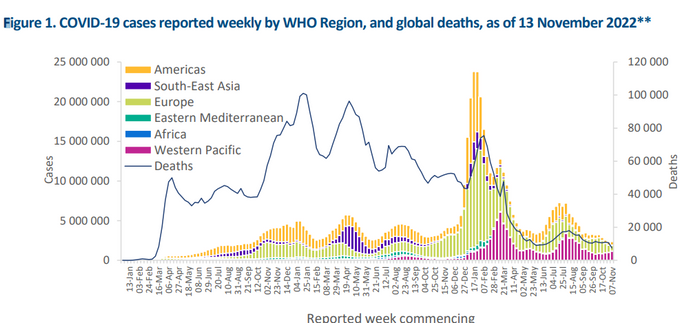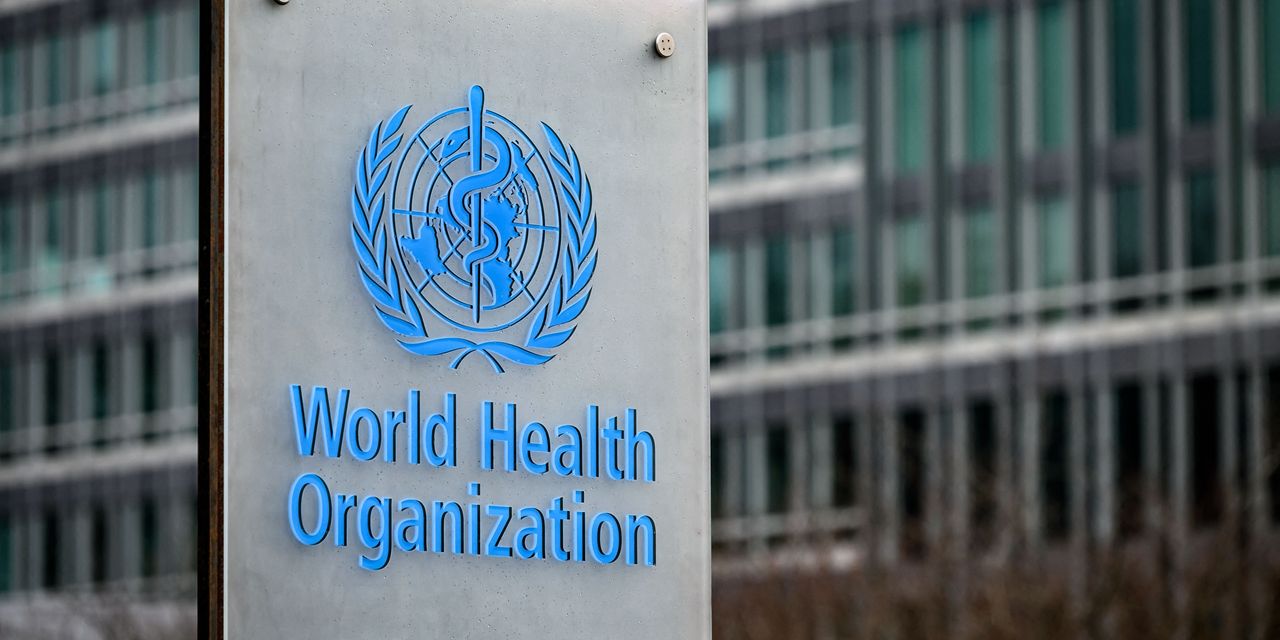The global tally of COVID-19 cases rose 2% in the week through Nov. 13 from the previous week, according to the World Health Organization, in a reversal of the trend of declining case counts that had been in place for weeks.
The rise was led by Japan, South Korea and the U.S., with cases climbing 25% in Japan, 19% in South Korea and 6% in the U.S. And that doesn’t tell the whole story.
“The true number of incident cases is an underestimate due to a decline in testing globally,” the agency cautioned in its weekly epidemiological update.
The number of deaths continued to fall, however, and was down 30% from the previous week. The BA.5 omicron subvariant remained dominant, accounting for 73.2% of all sequences sent to a central database, but cases of BQ.1 and BA.5 with additional mutations also rose.

SOURCE: World Health Organization
With COVID, flu and RSV, or respiratory syncytial virus, all circulating and threatening to overwhelm hospitals in some areas, the head of the WHO’s Pan American Health Organization called on countries in the Americas to take measures to keep communities safe, such as encouraging vaccination, surveillance, face masks and social distancing.
Carissa Etienne told reporters at a briefing that the measures are key in the lead-up to the holiday season, when people are expected to gather indoors in large numbers.
COVID cases alone rose 12% in the Americas in the latest week, according to WHO data.
“The rise of a single respiratory infection is a cause for concern. When two or three start impacting a population concurrently, this should put us all on alert,” Etienne said.
Known U.S. cases of COVID were flat on Wednesday from two weeks ago, with the daily average standing at 39,193, according to a New York Times tracker. But cases are rising sharply in some states, led by Nebraska, where they are up 840% from two weeks ago; Arizona, where they have climbed 110%; and Utah, where they are up 77%.
The daily average for hospitalizations is up 2% to 27,704, but again, that number is not uniform across the country. It is highest in Arizona, up 60% from two weeks ago; Colorado, up 59%; and Alaska, up 37%.
The daily average for deaths continues to decline and is down 13% from two weeks ago to 299.
Coronavirus Update: MarketWatch’s daily roundup has been curating and reporting all the latest developments every weekday since the coronavirus pandemic began
Other COVID-19 news you should know about:
• State health officials in New Mexico are encouraging the immunization of children against flu and COVID but are not making changes to the list of vaccines required for school entry in the fall of 2023, the Associated Press reported. On Wednesday, the New Mexico Department of Health announced its school immunization requirements for the next school year. There were no changes to the list of mandatory immunizations for infections including measles, mumps, tetanus, polio and chickenpox. Immunizations for flu, coronavirus and papillomavirus at appropriate ages are recommended but not required.
• China reported 23,276 new COVID infections on Wednesday, of which 2,388 were symptomatic and 20,888 were asymptomatic, the National Health Commission said on Thursday, Reuters reported. That compared with 20,199 new cases a day earlier, of which 1,623 were symptomatic and 18,576 were asymptomatic infections, which China counts separately. Excluding imported infections, China reported 23,132 new local cases, of which 2,328 were symptomatic and 20,804 were asymptomatic, up from 20,059 a day earlier.
• Experts are warning that Europe faces a “cancer epidemic” unless urgent action is taken to boost treatment and research after an estimated 1 million diagnoses were missed during the pandemic, the Guardian reported. The number is based on a report titled “European Groundshot — Addressing Europe’s Cancer Research Challenges: a Lancet Oncology Commission,” which brought together a range of patient, scientific and healthcare experts with detailed knowledge of cancer across Europe. “There is emerging evidence that a higher proportion of patients are diagnosed with later cancer stages compared with pre-pandemic rates as a result of substantial delays in cancer diagnosis and treatment. This cancer stage shift will continue to stress European cancer systems for years to come,” the report said.
Here’s what the numbers say:
The global tally of confirmed cases of COVID-19 topped 636.3 million on Thursday, while the death toll rose above 6.61 million, according to data aggregated by Johns Hopkins University.
The U.S. leads the world with 98.2 million cases and 1,075,951 fatalities.
The Centers for Disease Control and Prevention’s tracker shows that 227.8 million people living in the U.S., equal to 68.6% of the total population, are fully vaccinated, meaning they have had their primary shots.
So far, just 31.4 million Americans have had the updated COVID booster that targets the original virus and the omicron variants, equal to 10.1% of the overall population.


